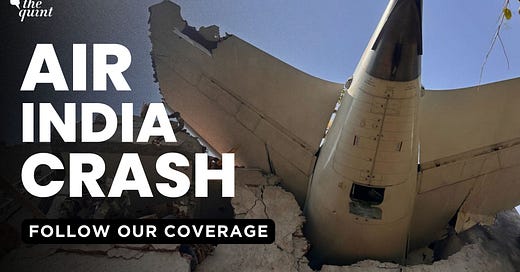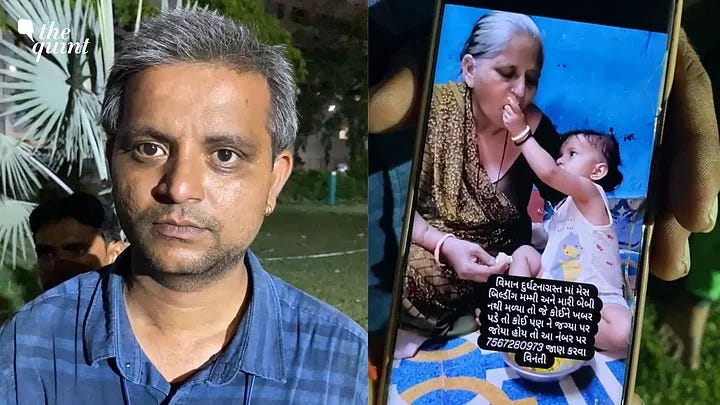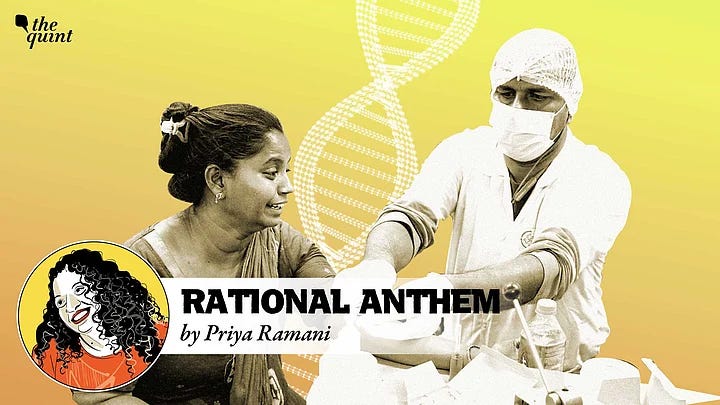The Question Is... Did the Air India Crash Scene Need to Become a Media Circus?
Help us continue to do more reports from the ground — become a member.
Dear Reader,
For the past week, I’ve been reporting from Ahmedabad on the crash of Air India flight AI171. The tragedy claimed the lives of 241 passengers on board, along with students and staff from the BJ Medical College hostel, and several local residents.
Reporting from the ground has been harrowing. Many victims’ bodies were severely burned and dismembered, making DNA identification with their closest next of kin the only option.
One week later, 210 victims have been identified, and 187 bodies have been handed over to families. While the government has yet to release an official death toll, ground estimates suggest that nearly 100 families may still be waiting for that one call from Ahmedabad Civil Hospital.
For the family of Javed Ali Syed, a British national, the wait lasted six days. Syed was killed in the crash along with his wife and two children.
'He Came For Eid & To See His Ailing Mother': Family Killed in Air India Crash
For Ravikumar Thakur, the ordeal is even more devastating. His mother, Sarlaben, who worked as a cook at the hostel, and his two-year-old daughter, Aadhya, are still missing. Their bodies have not been found, nor do their names appear on any of the victims' lists released by the hospital.
‘Checked Every Morgue’: Cook of BJ Hostel Mess Yet To Be Found
And then, there was 14-year-old Akash Patni, the son of a tea vendor who had his stall near the hostel. Akash was asleep when the plane crashed and was caught in the flames. His mother, who ran to douse her burning child, also suffered burn injuries.
Tea Vendor's Teen Son Killed by Falling Debris; Mother Survives
Hundreds of such stories have emerged from the tragedy, with families enduring the agony of waiting for DNA matches. But equally distressing was the conduct of the Indian media.
The Question is... Will Indian media ever choose empathy over clicks in times of tragedy?
The media's coverage was marred by a relentless pursuit of grief—hounding grieving families, dictating their words, and intruding into the homes of local residents. For seven days, I documented this media circus firsthand while reporting from the ground.
BTS of Air India Crash: How Media Hounded Families of Victims, Ahmedabad Locals
So many powerful stories from the ground deserved to be told...
Like the auto driver who saved street children despite suffering burn injuries..
“I Saw the Air India Plane Crash into the Building”: Injured Auto Driver Recalls Horror
Or the auto driver who made 100 coffins in which the bodies of the victims were carried...
The Ahmedabad Auto Driver Who Made 100 Coffins For Victims
Or the family of Lawrence Daniel Christian, who made coffins for the victims despite losing him in the crash...
Family Loses a Loved One in Crash, Makes Coffins for Victims
Instead, the reporters chose shouting into cameras or thrusting microphones into faces of the grieving families.
Alongside the sensationalism, misinformation prevailed. Speculation about the cause of the crash cause spread widely despite the lack of official details from the 'black box'. To understand the known facts and what the investigation may uncover, my colleague Tanishka Sodhi spoke to Captain Minoo Wadia, former Air India pilot and founder of the Federation of Indian Pilots.
'Not a Crash But a Controlled Crash Landing': Aviation Expert Minoo Wadia on Air India Crash
Another wave of misinformation on social media centered around alleged delays in DNA identification of victims. But according to doctors I spoke with, the reality was far more complex—many bodies were so badly dismembered and burned that identifying even a single DNA match among hundreds of remains was an enormous challenge. This was also confirmed by Dr Tamanna Parmar, a dentist involved in the DNA sampling, in a conversation with senior journalist Priya Ramani.
‘Nothing Survives Fire Except Teeth’: Dentist on DNA Tests of Air India Victims
In the past week, the Indian media did what it had to—and so did we. In moments like these, navigating the line between necessary reporting and respecting victims' grief becomes especially delicate.
My cameraperson, Shiv Kumar Maurya, and I did our best to strike that balance—by approaching those affected with empathy and respect. If you value this kind of journalism, please consider supporting our work by becoming a member.*
Feel free to connect with me at eshwar.gole@thequint.com at this difficult time. We are listening.
Thank you,
ESHWAR
Associate Editor
*Already a member of The Quint? What a star! Your support empowers us in our mission to question everything.
Want us to cover a story? Write to us at editor@thequint.com or reply to this email.





